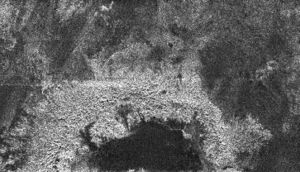تايتان
 Titan seen from the Cassini–Huygens spacecraft. | |
| الاكتشاف | |
|---|---|
| اكتشفه | Christiaan Huygens |
| تاريخ الاكتشاف | March 25, 1655 |
| التسميات | |
| زحل السادس | |
| الصفات | Titanian |
| السمات المدارية[1] | |
| 1221870 km | |
| Eccentricity | 0.0288 |
| 15.945 d | |
| Inclination | 0.34854° (to Saturn's equator) |
| Satellite of | زحل |
| السمات الطبيعية | |
نصف القطر المتوسط | 2576±2 km (0.404 Earths) [2] |
Mean radius | 2576±2 km (0.404 Earths) [2] |
| 8.3×107 km2 | |
| Mass | (1.3452±0.0002)×1023 kg (0.0225 Earths)[2] |
Mean density | 1.8798±0.0044 g/cm3[2] |
| 1.352 m/s2 (0.14 g) | |
| 2.639 km/s | |
| Synchronous | |
| Zero | |
| Albedo | 0.22[3] |
| Temperature | 93.7 K (−179.5 °C)[4] |
| 7.9 | |
| Atmosphere | |
Surface pressure | 146.7 kPa |
| Composition by volume | 98.4% nitrogen (N2) 1.6% methane (CH4)[5] |
تيتان Titan أشهر أقمار الكوكب زحل اكتشفه العالم الفلكي كريستيان هويجنز سنة 1655م وفى عصر الفضاء وفرت الأجهزة العلمية الفضائية (وخاصة برنامج فوياجير)بعض المعلومات التفصيلية عن القمر. وتيتان ثاني أكبر قمر في النظام الشمسي.
الخصائص الفيزيائية
R. Nemiroff, J. Bonnell (March 25, 2005). "Huygens Discovers Luna Saturni". Astronomy Picture of the Day. NASA. Retrieved 2007-08-18. يبلغ قطره نحو 5150 كيلو مترا (يقارب حجمه حجم عطارد) ومعدل بعده عن كوكبه الأم 1,222,000 كيلو متر .
الغلاف الجوي

هو القمر الوحيد بين الاقمار يمتلك جوا غازيا كثيفا وهو جو برتقالى اللون يتكون من النيتروجين في الدرجة الأولى وقليل من الهليوم والهيدروجين والميثان وغيرها من الغازات .وتبعا لسمك غلافه الغازى صار ضغطه شديدا على سطحه يعتقد أن بنية القمر مكونة من الصخور والجليد ودرجة حرارته على السطح تقدر بنحو 180 درجة تحت الصفر .
المناخ

السطح

السطح مغطي في بعض بقاعه ببحار من الميثان بين حالة السيولة والصلابة .
ولأهمية تيتان فقد أرسلت سنة 1997م المركبة الفضائية كاسيني الى زحل لينطلق منها سنة 2004م سابر فضائي خاص (اسمه هويجنز) لدراسة هذا القمر.
=تضاريس الظلام
المدار
ميزات المساحة

المراقبة والاستكشاف

شروط وامكانية الحياة على سطحه

معرض الصور
أنظر أيضا
- Colonization of Titan
- List of planetary bodies
- List of Solar System objects by radius
- Saturn's moons in fiction
- Timeline of discovery of Solar System planets and their moons
- Titan in fiction
المصادر
- مؤمن, عبد الأمير (2006). قاموس دار العلم الفلكي. بيروت، لبنان: دار العلم للملايين.
{{cite book}}: Cite has empty unknown parameter:|طبعة أولى coauthors=(help)
- ^ خطأ استشهاد: وسم
<ref>غير صحيح؛ لا نص تم توفيره للمراجع المسماةhorizons - ^ أ ب ت
R.A. Jacobson; et al. (2006). "The gravity field of the saturnian system from satellite observations and spacecraft tracking data". The Astronomical Journal. 132 (6): 2520–2526. doi:10.1086/508812.
{{cite journal}}: Explicit use of et al. in:|author=(help) - ^
D.R. Williams (August 21, 2008). "Saturnian Satellite Fact Sheet". NASA. Retrieved 2000-04-18.
{{cite web}}: Check date values in:|accessdate=(help) - ^
G. Mitri; et al. (2007). "Hydrocarbon Lakes on Titan" (PDF). Icarus. 186 (2): 385–394. doi:10.1016/j.icarus.2006.09.004.
{{cite journal}}: Explicit use of et al. in:|author=(help) - ^ خطأ استشهاد: وسم
<ref>غير صحيح؛ لا نص تم توفيره للمراجع المسماةNiemann
قراءات أخرى
- Lorenz, Ralph (2002). Lifting Titan's Veil: Exploring the Giant Moon of Saturn. Cambridge University Press. ISBN 0-521-79348-3.
{{cite book}}: Unknown parameter|coauthors=ignored (|author=suggested) (help); Unknown parameter|month=ignored (help)
وصلات خارجية
| Titan (moon)
]].- Cassini-Huygens Mission To Saturn & Titan. Multimedia Feature Titan Virtual Tour
- Titan Profile by NASA's Solar System Exploration
- Video of Huygens’ descent from the ESA
- Cassini Imaging Central Laboratory for Operations (2005). CICLOPS: Cassini Imaging. Retrieved March 28, 2005.
- European Space Agency. (2005). ESA - Cassini-Huygens. Retrieved March 28, 2005.
- Gangale, Thomas (2002). The Darian Calendar for Titan. Retrieved March 28, 2005.
- Hamilton, Calvin J. (2001). Titan - Saturn IV. Retrieved March 28, 2005.
- Hammerschlag, Michael (2005). CLOUD WORLD: MISSION to TITAN. Retrieved March 28, 2005.
- NASA (2005). NASA - Cassini-Huygens: Close Encounter With Saturn. Retrieved March 28, 2005.
- Perry, Jason (2005). Titan Today. Retrieved March 28, 2005.
- The Planetary Society (2005). TPS: Saturn's moon Titan. Retrieved March 28, 2005.
- University of Arizona Lunar and Planetary Lab (2005). Lunar and Planetary Lab The Descent Imager-Spectral Radiometer of the Cassini-Huygens Mission to Titan. Retrieved March 28, 2005.
- The Alien Noise. This recording is a laboratory reconstruction of the sounds heard by Huygens' microphones.














